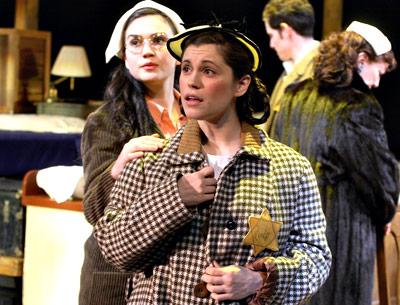Opinion: Bravo for ‘Anne Frank’!

Time, the cliché goes, heals all wounds. But there are some wounds that cannot, and should not, ever be healed. The Holocaust is one of them.
The Holocaust provides a daunting challenge to artists of all stripes: How do you speak the unspeakable, how do you depict evil in its purist form.
“The Diary of Anne Frank,” both as a piece of literature and as a theater piece, on view at the Bay Street Theatre in Sag Harbor, is one answer to that artistic challenge.
This staged version was written in 1956 by an incredible writing duo, the prolific and gifted Frances Goodrich and Albert Hackett. They are known for sensitive yet powerful works, particularly for Hollywood, like “The Thin Man” series, and “It’s a Wonderful Life.”
The reason why “Anne Frank” works is because it is not a “plight” play. Plight plays tend to be didactic appeals for the audience’s sympathy.
Instead, “The Diary of Anne Frank” is a look at an oppressed group trying to live a normal life under impossible conditions. But, as hard as they try, normality is something none of them would ever see again.
The Bay Street cast is an excellent one put together by the director Joe Minutello, starting with Jessica Mortellaro as Anne. She captures the intelligence as well as the explosive precocity of the character.
Written between June 14, 1942, and Aug. 1, 1944, by a 13 year-old German-born Jewish girl who had been brought by her parents to Amsterdam after the Nazis took power in 1933, “The Diary of Anne Frank” was first published as a work of nonfiction in its original Dutch in 1947.
After the Nazis conquered Holland, Otto and Edith Frank-Hollander elected to go into hiding with Anne and her sister, Margot, rather than risk being caught fleeing to Switzerland, one of the few safe harbors left in Europe.
They moved into an attic over a store. During the day, they could not make a sound, lest the workers below heard them. Cooking, smoking, even flushing a toilet was forbidden.
The day the family moved into this netherworld, Mr. Frank gave his daughter something she’d always wanted: a diary.
A brilliant writer, and at the same time a young teenager going through normal growing pains, she gave the world a glimpse into the Franks’ secret world, which they shared with four other Jews in hiding.
Keith Cornelius is wonderful as the father, the only one who survived the concentration camps the eight attic inhabitants were taken to by the Green Police, under the bidding of the Gestapo. Mr. Cornelius gives us a broken man at the beginning of the play who finds redemption through the words of his dead daughter in the diary given to him by Miep (Chloe Dirksen) and Mr. Kraler (Joe Pallister). Miep and Mr. Kraler were the Dutch citizens who risked everything to hide the eight Jews. Mr. Pallister and Ms. Dirksen make us care without asking us to, which can also be said for the rest of the cast.
It’s wonderful to see Josh Gladstone onstage with his wife, Kate Mueth, as Mr. and Mrs. Van Daan, a Jewish couple in hiding with their 16-year-old son, Peter Van Daan (Sawyer Avery). They are a talented duo here, finding the humor and then the pathos, again without pushing the issue. The same could be said for Mr. Sawyer.
Lydia Franco-Hodges (Mrs. Frank), Georgia Warner (Margot Frank), and Terrance Fiore (Mr. Dussel) round out this excellent cast.
As always, the technical elements of this Bay Street production are superb. The set by Gary Hygom is a wonderful playing space, and the light design blends in with the sound design (not credited), providing a frightening world where every whistle in the street stops the action on the stage, out of palpable terror.
While the sound design was perfect, the musical underscore seemed to be a comment on a comment, undercutting the power of the simple spoken word. The recorded piano tinkling in a minor key, accompanied by a similar sounding violin, was, and I hate to use this word in connection with such a serious subject, almost schmaltzy. You don’t need to ask the audience to cry, just trust them.
The postscript, in which the actors walk onstage after the play to tell the audience what happened to the characters, would have been better in the program. After the slightly less than two-hour play, with no intermission, the audience, many of whom were crying, began to applaud, releasing the energy they have built up watching this moving work. Then, whoops, not so fast, time for the postscript.
Although Scott Schwartz, the new artistic director for Bay Street, was not involved in this production (he told the audience before Saturday night’s performance that this was the first time he had seen it), it is in keeping with his stated goal of expanding the theater’s Literature Live! Series, along with other community outreach programs.
It was wonderful to see a mix of ages in the large audience, which is the idea.
Bravo, Bay Street, bravo.
